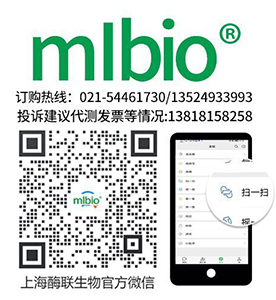產品貨號 : mlR18789
英文名稱 : Meprin beta
中文名稱 : 苯甲酸肽水解酶β抗體
別 名 : Endopeptidase 2; kinase splitting membranal proteinase; KSMP; Meprin 1 beta subunit; Meprin A beta; Meprin A beta subunit precursor; N benzoyl L tyrosyl P amino benzoic acid hydrolase beta subunit; PABA peptide hydrolase; PPH beta.
研究領域 : 細胞生物 信號轉導 泛素 細胞膜蛋白
抗體來源 : Rabbit
克隆類型 : Polyclonal
交叉反應 : Human, Mouse, Rat, Chicken, Dog, Horse, Rabbit,
產品應用 : ELISA=1:500-1000 IHC-P=1:400-800 IHC-F=1:400-800 ICC=1:100-500 IF=1:100-500 (石蠟切片需做抗原修復)
not yet tested in other applications.
optimal dilutions/concentrations should be determined by the end user.
分 子 量 : 82-110kDa
細胞定位 : 細胞膜
性 狀 : Lyophilized or Liquid
濃 度 : 1mg/ml
免 疫 原 : KLH conjugated synthetic peptide derived from human Meprin beta:151-250/701 <Extracellular>
亞 型 : IgG
純化方法 : affinity purified by Protein A
儲 存 液 : 0.01M TBS(pH7.4) with 1% BSA, 0.03% Proclin300 and 50% Glycerol.
保存條件 : Store at -20 °C for one year. Avoid repeated freeze/thaw cycles. The lyophilized antibody is stable at room temperature for at least one month and for greater than a year when kept at -20°C. When reconstituted in sterile pH 7.4 0.01M PBS or diluent of antibody the antibody is stable for at least two weeks at 2-4 °C.
PubMed : PubMed
產品介紹 : Meprins are multidomain zinc metalloproteases that are highly expressed in mammalian kidney and intestinal brush border membranes, and in leukocytes and certain cancer cells. They are involved in the hydrolysis of a variety of peptide and protein substrates, and have been implicated in cancer and intestinal inflammation. Mature meprins are oligomers of evolutionarily related, but separately encoded alpha and/or beta subunits. Homooligomers of alpha subunit are secreted, whereas, oligomers containing the beta subunit are plasma membrane-bound. This gene encodes the beta subunit. Targeted disruption of this gene in mice affects embryonic viability, renal gene expression profiles, and distribution of the membrane-associated alpha subunit in kidney and intestine. [provided by RefSeq, Oct 2011]
Function:
Membrane metallopeptidase that sheds many membrane-bound proteins. Known substrates include: FGF19, VGFA, IL1B, IL18, procollagen I and III, E-cadherin, KLK7, gastrin, ADAM10, tenascin-C. The presence of several pro-inflammatory cytokine among substrates implicate MEP1B in inflammation. It is also involved in tissue remodeling due to its capability to degrade extracellular matrix components.
Subunit:
Homotetramer consisting of disulfide-linked beta subunits, or heterotetramer of two alpha and two beta subunits formed by non-covalent association of two disulfide-linked heterodimers By similarity. Interacts with MBL2 through its carbohydrate moiety. This interaction may inhibit its catalytic activity.
Subcellular Location:
Cell Membrane; single-pass type I membrane protein.
Tissue Specificity:
The major site of expression is the brush border membrane of small intestinal and kidney epithelial cells.
Post-translational modifications:
N-glycosylated; contains high mannose and/or complex biantennary structures. Ref.6 Ref.14
O-glycosylation protect the C-terminal region from proteolytic cleavage and diminish secretion, this seems to be specific to human.
Proteolytically activated by trypsin in the intestinal lumen and kallikrein-related peptidases in other tissues.
Similarity:
Belongs to the peptidase M12A family.
Contains 1 EGF-like domain.
Contains 1 MAM domain.
Contains 1 MATH domain.
SWISS:
Q16820
Gene ID:
4225
Important Note:
This product as supplied is intended for research use only, not for use in human, therapeutic or diagnostic applications.











